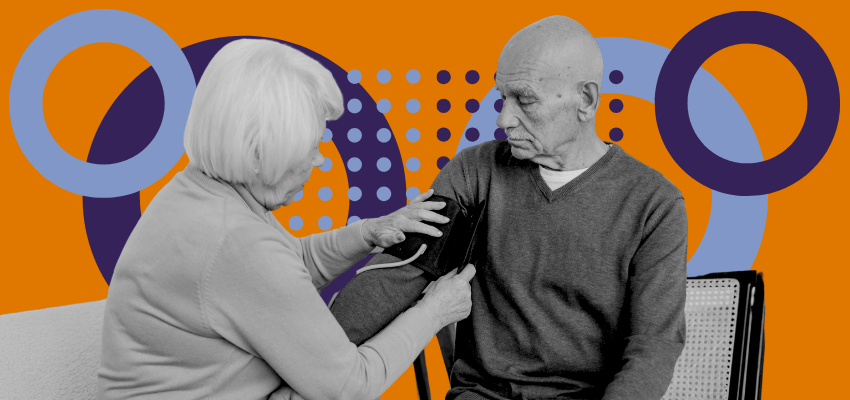What Are the Medicare Hospice Aid Supervision Policies?
October 29th, 2025
5 min read
By Abigail Karl

If you manage a hospice agency, you already know how vital your aides are to patient care. Hospice aides often spend more time in patients’ homes than any other team member. They provide comfort, dignity, and consistency in daily care. Because of their essential role, the Conditions of Participation (CoPs) place strict requirements on how aid services are supervised.
When those rules aren’t followed precisely, surveyors take notice.
Many hospice leaders ask:
- How often do hospice aides need to be supervised?
- Does the aide have to be present?
- What happens if concerns are identified?
*This article was written in consultation with Mariam Treystman.
At The Home Health Consultant, we’ve guided hundreds of Medicare-certified hospice and home health agencies through surveys, audits, and plans of correction. We know firsthand how something as small as a missing supervisory signature can become a deficiency that threatens your compliance record.
This article walks through the CoPs governing hospice aides, from supervision to training requirements, in plain English. After reading, you and your team will know exactly what’s required to stay compliant and confident.
What Qualifications Must Hospice Aides Meet Before Providing Care?
Before they can provide care, a hospice aide must meet at least one of the following qualifications:
- Completion of a hospice aide training and competency evaluation program, or
- Completion of a state-approved nurse aide training and competency evaluation program, or
- Licensure under a state licensure program for aides.
If a hospice aide has not worked for compensation as an aide in 24 months, they must complete retraining and a competency evaluation before resuming patient care.
Example:
If an aide last worked in 2022 and your agency hires them in late 2024, they must repeat both classroom and skills training (even if their certificate hasn’t expired), because the two-year lapse resets their competency.
What Training and Competency Standards Must Hospice Aides Meet?
Hospice aide training must include at least 75 hours of instruction, with:
- 16 classroom hours before clinical training, and
- 16 hours of supervised practical experience where the aide demonstrates skills under direct observation
Hospice aid training covers everything from but not limited to:
- Communication
- Infection control
- Basic anatomy
- Safety
- Patient rights
- Personal care tasks (such as bathing, grooming, and mobility assistance)
Competency evaluations include both written/oral testing and direct observation of skills. To read our deep dive on home health and hospice competencies, check out the article below.
If an aide fails any skill, they must be retrained and re-evaluated before performing that task independently.
Example:
During evaluation, if an aide incorrectly performs perineal care, they must receive targeted retraining on infection prevention and privacy techniques before resuming that duty.
How Often Must Supervisory Visits Be Conducted for Hospice Aides?

The CoPs require registered nurses (RNs) to verify the quality of aide services and ensure care aligns with each patient’s plan of care.
Supervisory visits must occur:
- Every 14 days: An RN conducts an on-site visit to review care quality and documentation. The aide does not have to be present.
- Pro Tip: Because the RN must visit the patient onsite every 14 days in hospice to re-eval and update the care plan, it’s great practice to work supervisory visits into this schedule.
- *On the First Visit: Our recommendation is to always start supervision on the first visit. While CMS CoPs don't specify when supervision should begin, this is based on our lived-experience attending surveys. We've seen multiple instances of surveyors, over a wide span of years, attempt to give conditional deficiencies due to the first aide visit not being supervised.
Here's the surveyor reasoning: There are extremely strict requirements that CHHAs must be supervised every 14 days. If an aide starts seeing a patient, and is not supervised until two weeks after they've been seeing the patient, this is a lapse in ensuring the CHHA is qualified to be delivering that care.
- Annually: Each aide must be observed in person at least once every 12 months performing care tasks to confirm ongoing competency.
- *As needed: If concerns arise about aide performance, the RN must perform an additional on-site visit with the aide present.
- *Important Note: The CoPs don’t define “as soon as possible,” but agencies should act promptly enough to protect patient safety.
- Example: If a patient’s family reports that an aide has been rough during transfers, the RN should not wait until the next 14-day review. A same-week visit, with the aide present, should be conducted to observe technique and provide coaching.
What Must Be Evaluated During a Hospice Aide Supervisory Visit?
During a supervisory visit, the RN must confirm that the aide:
- Follows the patient’s plan of care
- Performs assigned tasks safely and competently
- Maintains infection control and hygiene
- Communicates effectively with patients, families, and the interdisciplinary team
- Observes and reports changes in condition accurately
- Honors patient’s rights
Example:
A supervisor might review how the aide documents skin changes on the visit note, or observe whether they properly sanitize equipment between patients.
These visits are not just clinical check-ins. They’re opportunities to reinforce quality, safety, and professionalism.
What Happens if Errors Are Found During Hospice Aide Supervision?
If a supervisor identifies a performance issue:
- The deficiency must be clearly documented.
- The aide must receive retraining on the deficient and related skills.
- After retraining, the aide must undergo a competency re-evaluation.
- Only after successfully passing can the aide resume performing that task independently.
Example:
If an aide fails to change gloves between wound-care patients, retraining should include infection control, glove removal, and cross-contamination prevention, not just that single step.
This corrective process protects patients while maintaining fairness to staff.
What Are the Documentation Requirements for Hospice Aide Supervision?

Agencies must maintain clear records showing compliance with supervision and competency requirements:
- Initial training and competency evaluation results
- Annual in-service records (minimum 12 hours per year)
- Supervisory visit logs (including dates and whether the aide was present, as well as the completed supervisory forms for each supervision event)
- Documentation of deficiencies, retraining, and re-evaluation outcomes
Example:
Surveyors often ask to see the last 3 months of supervision logs. If your documentation only shows the 14-day visits but not the corrective follow-up visit if an error was found, it’s an immediate deficiency.
There’s no required format from CMS for how to keep these logs. Agencies can use digital logs or handwritten forms, as long as records clearly demonstrate compliance.
What Are Common Mistakes Hospice Agencies Make with Aide Supervision?
Even strong agencies get cited for errors that could have been avoided. The most common mistakes agencies make include:
- Missing on-site verification: RNs document supervision but never actually visit the patient’s home.
- Incomplete logs: No clear evidence the aide was observed annually.
- Delayed follow-ups: Supervisors wait weeks after identifying a deficiency to re-evaluate.
- Unclear delegation: Supervisory responsibilities passed to unqualified staff.
- Documentation gaps: Missing RN signatures or incomplete visit notes.
Example:
A hospice agency had perfect clinical care but failed to keep proof of one aide’s annual competency check. During survey, that single oversight was cited under 418.76(h) as a deficiency—despite excellent patient outcomes.
These errors are preventable when agencies establish a routine tracking system and hold supervisors accountable for timely documentation.
How Can Hospice Agencies Stay Compliant with Aide Supervision Policies?
Hospice aide supervision isn’t just a regulatory formality. It’s a cornerstone of safe, compassionate end-of-life care.
To stay compliant:
- Conduct and document every 14-day supervisory visit on-site.
- Schedule annual direct observations for each aide.
- Retrain and re-evaluate promptly when issues arise.
- Maintain organized records to prove compliance during survey.
- Regularly audit supervision logs for missing or late entries.
Aide supervision is one part of the larger compliance framework your hospice depends on. To learn how these standards apply across all disciplines, read our companion article: Supervision Policies for Other Disciplines in Home Health and Hospice.
*Disclaimer: The content provided in this article is not intended to be, nor should it be construed as, legal, financial, or professional advice. No consultant-client relationship is established by engaging with this content. You should seek the advice of a qualified attorney, financial advisor, or other professional regarding any legal or business matters. The consultant assumes no liability for any actions taken based on the information provided.
Topics:
















